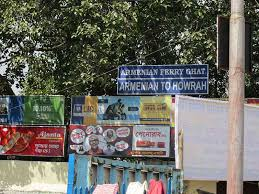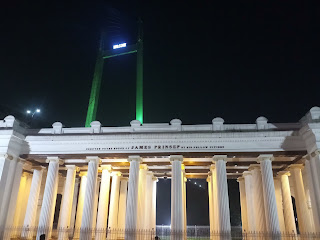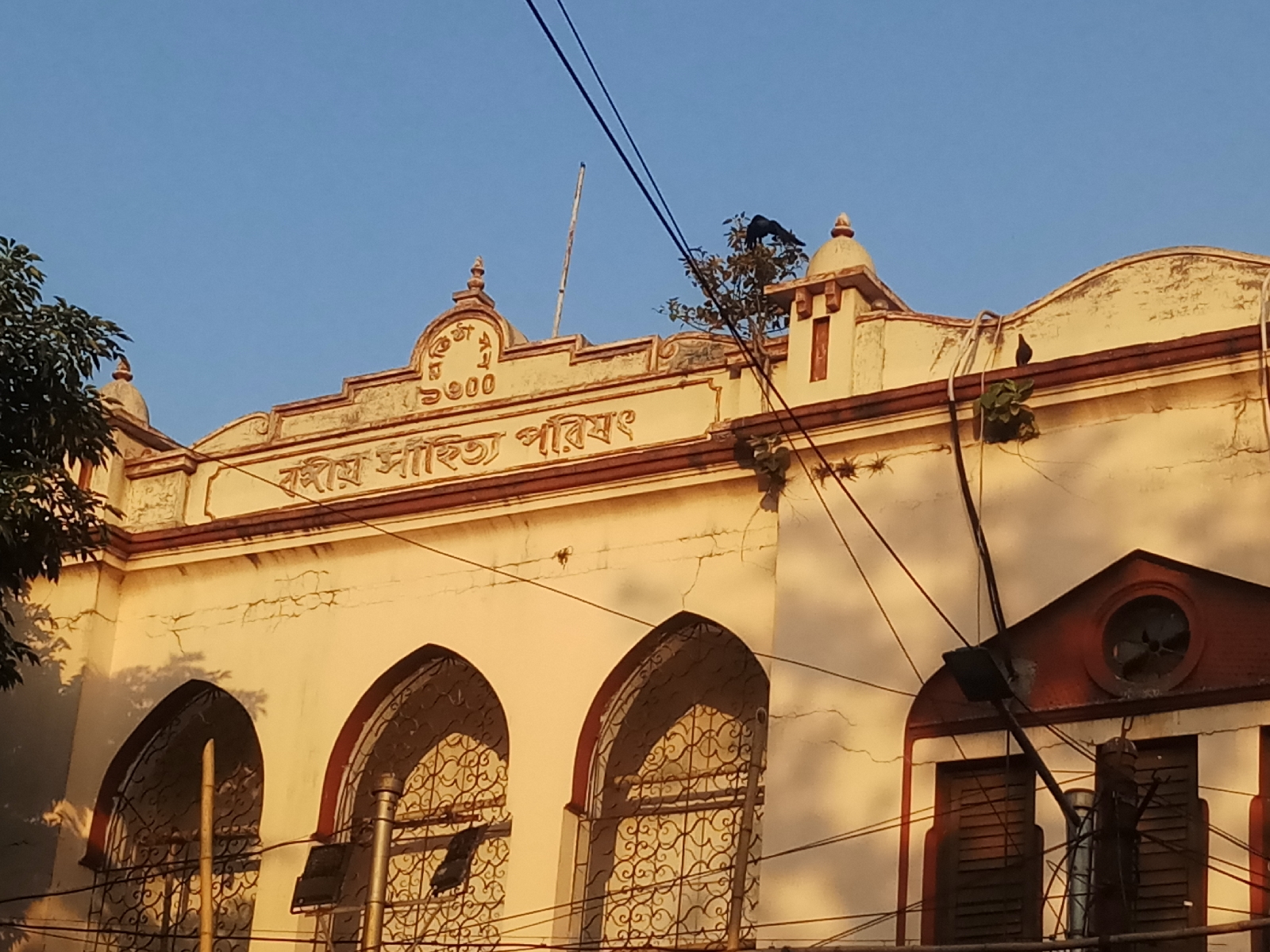The Hoogly River
runs through the side of Kolkata and the many iconic ghats on its bank are a
part of the city’s heritage being used for daily chores and religious
activities. The
river ghats are connected with almost all events of life and death bears
testimony of the cultural and socio-economic dimensions of the people of Calcutta.
Most of these ghats were built by zealous men and women both natives and
foreigners for societal benefit. Harisadhan listed names of 39 Ghats that
existed between Bagbazar and Chandpal Ghat in 1793. Cones’ Calcutta Directory
listed as many as 58 ghats existed in 1874 between Bagbazar and Tolly’s Nullah.
With the river changing courses, some old
ghats have been destroyed and many have changed names than those appearing in
old maps. About a hundred ghats line the river banks on both the Calcutta and Howrah side of the Hooghly. Built for vessels to dock in, the majority of them are used by bathers in the sacred Ganges as per Hindu mythology. Ornate ghats were constructed by the rich and powerful, as marks of prestige, philanthropy as well as to immortalize a loved ones in architechtural constructions.
1. Princep Ghat - The
ghat was built in 1843, with the white pillared Palladian porch designed by W.
Fitzgerald being constructed in the memory of the Anglo-Indian scholar James
Prinsep. Prinsep came to India in 1819 and joined the Calcutta Mint in 1829. He
was the Secretary of the Asiatic Society of Bengal. Some of his notable
contributions were preparation of Bhrami and Kharosthi scripts, introduction of
uniform coinage system, reformation of weights and construction of circular
canals connecting Hoogly river and Sunderbans.
2. Babughat - The ghat, named after
Babu Raj Chandra Das, zamindar during the colonial era was built in his memory
by his wife Rani Rasmoni in 1830. Built in the Doric-Greek architecture it is a
ferry ghat for passengers and vendors as well as a tourist spot.

3. Outram ghat - built
in the late 19th Century in honour of Sir James, a general. British East India
Company During the colonial era, the ghat was a port to ships sailing to East
Bengal and Burma, Today it is noted for the immersion ceremony during Durga
Pujo and for sightseeing.
4. Bagbazar Ghat and Sarada Ghat/ Mayer Ghat- The ghat has another specific
section called Mayer Ghat, which is a bathing area that was used by religious
and cultural figure Ma Sharada. Previously it was named as ‘Rogo Meeter's Ghat,’ after Raghu Mitra, the
son of Gobindram Mitra, the second Indian deputy collector. Along the Bagbazar ghat there are two temples dedicated to Shiva and Lokenath Baba. Originally it was named after its builder Rajballabh Sen, philantrophist and political person during the era of Mir Zafar and Siraj - ud- Daula.

 |
| Picture from internet |
 |
| Picture from internet |
 |
| Picture from internet |
5. Judge's Ghat - Constructed by Sir Elijah Impey (infamously known for the judicial murder of Maharaja Nandakumar and the first chief justice of the Supreme Court at Fort William in 1732), this ghat is situated to the north of Prinsep Ghat. It was designated for the use of the dignified British officials, especially Judges, posted by the Empire in India. It is also known as the Gwalior Ghat, perhaps because of its nearness to the Gwalior Monument. There is a shaded concrete space overlooking the water body for performing the religious rituals.
6. Mullick Ghat/ Chotelal ki Ghat
The
Chotulal Ghat, also known as Chotelal Ki Ghat, is situated next to Jagannath
Ghat along the Hoogly River.According
to one view, Chhotey Lal Durga Prasad was a practitioner of law at the Calcutta
High Court with immense wealth and fame. He visited a temple of Lord Shiva to
pray for a heir where he met a faqir,
who asked him to build the ghat and subsequently his wish was fulfilled. The
other story goes that Baboo Chotelal Durga Prasad was a merchant at Radhabazar
and o had a business in princely state Furruckabad, now in Uttar Pradesh. After
his death, in 1872, his heirs handed an amount of rupees one lakh to the Calcutta
Port Commissioners to construct a bathing ghat in his honor. The structure of
the ghat was designed by Richard Bayne and completed in 1875 and comprised of a
single storied European classical style round room. Much of its previous elegance and glory has been lost and the
ghat has a jostling flower market and a wrestling akhra at its vicinity. Chatulal Ghat, is the name known today in lieu of Mullick Ghat. It is
frequented by movie-makers and tourists and functions nowadays as dharamsala. There
is a white marble plaque embedded high up on the wall, which states that, it
was dedicated by a few English women to the memory of those pilgrims, mostly
women, who perished in the cyclone of 25th May, 1887.
Besides the flower market is the Jagannath Ghat built in the 1760s by merchant and trader Shobharam Basak, whose family deity was Lord Jagannath.
7. Nimtala Ghat- This ghat lies adjacent to the Hindu crematorium and Baba Bhootnath temple is located on Beadon Strret, Ahiritola. It has witnessed the last journey of prominent personalities like Pandit Ishwar Chandra Vidyasagar, Rabindranath Tagore, Acharya Prafulla Chandra Ray and Tarashankar Bandyopadhyay.
.8. Pathuria Ghat - Dating back to the late 18th century this ghat probably derives its name from the building material pathor/ stone.
9. Ahiritola Ghat - This ghat was used by milkmen called as ahir to bathe their cattle, hence the nomenclature. Now it is used for immersion of deities and launch services for transportation.
10. Kumortuli Ghat - This ghat was used by idol makers and potters to obtain clay, mud and bamboo straws for building their sculptures and commodities; kumor = clay artisans and tuli = para.
11. Sovabazar Ghat - The members of the Sovabazar Deb family built this ghat for public benefit. The ghat overlooks many ancient buildings and the Cossipore Gun and Shell Factory.
12. Armenian Ghat - This ghat was constructed by Manvel Hazaar Maliyanuring in 1734, who like other members of the Armenian community had immense contribution towards the development of infrastructure, trade and commerce of Calcutta under the British rule. Its purpose was to facilitate docking of ships and storing of mercantile. The magnificent cast iron structure befits its prominence in the bygone era.
 |
| Picture from internet |
 |
https://www.facebook.com/photo/?fbid=528506085953402&set=pcb.528507155953295
|
13.Chandpal Ghat - The ferry services plies to Howrah and Shibpur from here. Chandpal was an ordinary shop owner after whom the ghat somehow derived its name. In colonial Bengal, it was proclaimed as the busiest ferry ghat and is mentioned as the southernmost ghat on Hooghly, in the ‘Plan of Fort William and part of the city of Calcutta’ surveyed in 1753. Sir Philip Francis and his fellow Councillors of the Supreme Council of India under the East India Company, disembarked here in 1774. Lord Cornwallis was the first Governor General of India, who landed here on 12th September 1786.
 |
| Picture from internet |
 |
| Picture from internet |
14. Motilal Seal Ghat - Constructed in Classical style with four tall Corinthian columns to support the parapet has lost much of its architectural grandeur as it is surrounded by, mostly makeshift and illegal, warehouses. This bathing ghat was constructed by Motilal Seal (sometimes called as Mutty Lall Seal), one of the leading businessman and philanthropist who donated land for Calcutta Medical College.
 |
https://www.facebook.com/photo/?fbid=528506302620047&set=pcb.528507155953295
|
15. Ramchandra Goenka Zenana Ghat
On the Kolkata side of the Howrah Bridge, walking past the vibrant flower market, one reaches the Rai Bahadur Bissessur Lall Hurgobind Sradh Ghat. The gentleman after whom the ghat is named was a rich Marwari businessman, and his “sradh” ceremony was conducted on that spot. The ghat that was erected in 1916. In front of the ghat a raised area with parallel bars was in use as a wrestling ring by local “pehelwans”. Nearby are also five banyan trees, each containing a small shrine at its base.
Next, the Ram Chandra Goenka Zenana Bathing Ghat was used by ladies. Ram Chandra Goenka is of the famous Goenka business family of Calcutta. He was the father of Sir Hariram Goenka and Sir Badridas Goenka, and his great great grandsons Harsh and Sanjiv Goenka lead their business empire today. The ghat with it’s beautiful dome and four minars at the four corners is often mistaken for a mosque, and is easily visible to commuters on the Howrah bridge. Ramchandra Goenka had a reputation for philanthropy. Next to the Goenka Ghat is the Gunput Ray Kayani Lady’s Ghat.
 |
https://www.facebook.com/photo/?fbid=528506669286677&set=pcb.528507155953295
|
16. Prasanna Tagore Ghat
Prasanna Kumar Tagore (1801–1886) was the son of Gopi Mohan Tagore, one of the founders of Hindu College. He belonged to the Pathuriaghata branch of the Tagore family. He was a prominent social reformer and played a significant role in the spread of education. The ghat was probably named after him to symbolise his multifaceted contributions in the upliftment of the then Hindu society. The rabindrasangeet 'Banglar maati Banglar jol' was sung here for the first time and on Raksha Bandhan members of the Tagore family performed the ritual of tying rakhi in an auspicious manner.
 |
| https://www.facebook.com/photo/?fbid=528507075953303&set=pcb.528507155953295 |
 |
| https://www.facebook.com/photo/?fbid=528507032619974&set=pcb.528507155953295 |
17. Adya Sraddha Ghat at Rai Soorajmull Ghat
The architechtural style has distinct features of Hindu temple
 |
https://www.facebook.com/photo/?fbid=528507135953297&set=pcb.528507155953295
|
References:
https://noisebreak.com/heritage-ghats-calcutta/
https://puronokolkata.com/tag/chotelal-ki-ghat/
https://www.telegraphindia.com/my-kolkata/places/learn-about-kolkatas-jagannath-ghat-nimtala-ghat-ahiritola-ghat-pathuria-ghat-kumartuli-ghat-sovabazar-ghat-bagbazar-ghat-mayer-ghat-babughat-and-prinsep-ghat-photogallery/cid/1851650
https://www.kolkataonwheels.com/story-details/181














































Excellent... Simply love reading your blog...
ReplyDelete